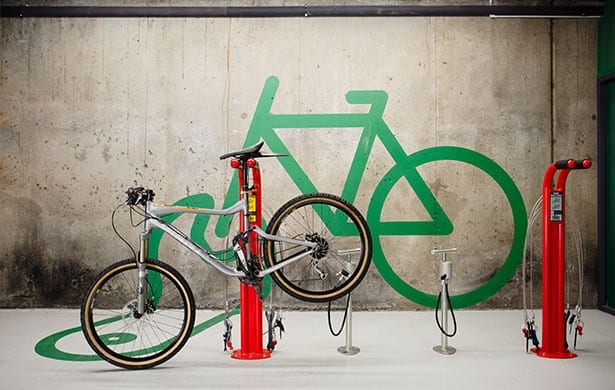 The university cited Google’s innovative workplaces as a model for the Knowledge Dock|Oversized graphics in bold colours have made the 15-year-old building a more enticing place to visit|Students want quality facilities or they will move on, says Gensler|Graphics connect the two floors via the stairwell and used that visual language to differentiate floors|”It is not just about where you are located on a league table – it is about providing an adequate student experience”|The project was as much about connecting space as it was people|The project was as much about connecting space as it was people|Shared working spaces are distinctly businesslike in look|Colourful furniture tie in with the bold graphics||
The university cited Google’s innovative workplaces as a model for the Knowledge Dock|Oversized graphics in bold colours have made the 15-year-old building a more enticing place to visit|Students want quality facilities or they will move on, says Gensler|Graphics connect the two floors via the stairwell and used that visual language to differentiate floors|”It is not just about where you are located on a league table – it is about providing an adequate student experience”|The project was as much about connecting space as it was people|The project was as much about connecting space as it was people|Shared working spaces are distinctly businesslike in look|Colourful furniture tie in with the bold graphics||
Inspired by the TMT sector’s spirit of collaboration, the university of east london’s knowledge dock is where start-ups and students can share space
With student tuition fees consistently on the up, the need for universities to turn young minds into eminently employable beings is far greater than before. Though it is by no means the only one, the University of East London has a dedicated facility, the Knowledge Dock Business Centre, which houses a mixture of exhibition, events and social space while providing offices for local businesses.
The idea is that students from across campus can not only study or do group-work in the building, but possibly meet a future employer.
The problem with the existing 15-year-old building was that, as technology had moved on, it was no longer fulfilling its purpose. Doors remained closed and the co-learning atmosphere that was intended to develop was being stifled.
“The confines of the space meant that these small companies that could be helping students were not fostering that kind of interaction,” says project architect Maria Nesdale of Gensler, which was drafted in following a tender to reinvent the warehouse-like space.
“The brief mentioned Google, which got us interested, but it also set alarm bells ringing,” she continues. “We thought, what did they mean? Did they want slides?”
It soon became apparent, however, that it was the perceived collaborative nature of the TMT industry that appealed, rather than its design cliches. To this end, the main structural interventions involved removing walls and opening up the spaces to create a more inclusive feeling that would encourage relationships to form.
However, owing to the tightness of both budget and programme, other measures were a little more complicated. For instance, the university could only commit to overhauling the ground and second floors while leaving the first floor untouched. Gensler developed graphics to connect the two floors via the stairwell and used that visual language to differentiate those floors from the ones left untouched.
“We had the idea of a ‘ribbon’, like a trail of breadcrumbs, to link the business-facing concierge-type reception through to the cafe presentation area and up the stairwell to the more focused upstairs areas,” says Nesdale.
In keeping with the TMT sensibility, flexibility is the watchword; the seminar rooms on the ground floor, which are augmented with presentation screens, are freely available for anyone to use. In terms of furniture and the organisation of space, the onus is on anyone – be they students, professors or businesspeople – being able to bag an area and chat.
In keeping with a typical tech workplace, much of the furniture is akin to what you might see in a professional environment. “The value of a business-facing environment is really helpful in terms of attraction of students,” says Nesdale.
“Universities have to be more competitive these days. It is not just about where you are located on a league table – it is about providing an adequate student experience. If a student doesn’t feel that they are getting that space, then they are going to walk.”































